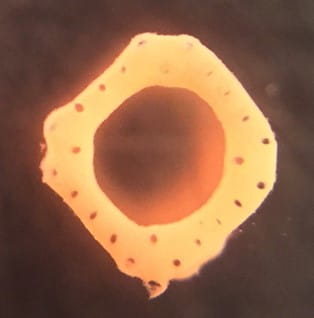The American Society of Transplant Surgeons recently recognized Burcin Ekser, MD, PhD, associate professor of surgery at the Indiana University School of Medicine and a transplant surgeon with IU Health with the 2022 ASTS Rising Stars in Transplantation Surgery Award. Recipients of the Rising Star award are nominated by two of their colleagues and must be a lecturer, assistant professor or associate professor on the tenure or non-tenure track, and have an MD and/or a PhD, with 6-15 years of specialty experience post fellowship.
“We are thrilled that Dr. Ekser was recently recognized by the American Society of Transplant Surgeons as a 2022 Rising Star,” said Michael G. House, MD, Interim Chair of the IUSM Department of Surgery. “This recognition is fitting for an outstanding surgeon who is committed to pioneering new advances in liver transplant surgery and breakthroughs for treating liver cancer. Dr. Ekser’s research in 3D bioprinting and organogenesis will have an enormous impact for years to come.”
Dr. Ekser is a multi-organ transplant surgeon specializing in liver and intestinal transplantation. He is also director of IU School of Medicine’s Transplant Research and Xenotransplantation Research Laboratory, where he explores transplant immunology, liver pathobiology, genetic engineering, xenotransplantation research and scaffold-free 3D bioprinting of organs and organ models.
“I am very honored to receive this prestigious award,” Dr. Ekser said. “The ASTS Rising Star in Transplantation Surgery Award is a special recognition from colleagues, especially senior colleagues, that see you as a future star in the field. I am also extremely grateful to all my colleagues within the transplantation program, who help make my clinical work and xenotransplantation research possible.”
He is especially grateful to those who nominated him, including Jonathan A. Fridell, MD, chief, Division of Abdominal Transplant Surgery and professor of surgery at IU School of Medicine; James Markmann, MD, PhD, chief of the Division of Transplantation at Massachusetts General Hospital and the Claude E. Welsh Professor of Surgery at Harvard Medical School; his mentor and pioneering xenotransplantation researcher, David K.C. Cooper, MD, PhD, professor of surgery at Harvard Medical School; and Ginny L. Bumgardner, MD, PhD, professor of transplant surgery at Ohio State University.
Currently, more than 106,000 men, women and children are on the national transplant waiting list in the United States and 17 people die each day waiting for an organ transplant. Dr. Ekser would like to improve the odds of surviving by researching transplant alternatives such as xenotransplantation – transplanting organs and tissues from another species to a human as well as 3D bioprinting to overcome organ shortage.
“In xenotransplantation, it’s using a genetically engineered pig for human transplantation purposes, which is ethically accepted,” Dr. Ekser explains. “There are barriers, especially immunological barriers and compatibility barriers that we are trying to understand. That’s one side of the research we are conducting, and we are now more excited than ever with the recent news of the ‘first-in-man’ genetically engineered pig heart transplant into a patient. In the long run, we would like to print our organs with a technology called 3D bioprinting. This is not a 3D printer, but rather a 3D bioprinter.”
Dr. Ekser worked with other investigators at the IU School of Medicine to build a model the size of a mouse’s liver that they can now bioprint. 
“We are now testing the functionality of the model,” Dr. Ekser said. “Because the liver has so many different cells, not just one cell line, we created a 3D organoid, 3D liver model in the lab. We integrated the cells, like a mixture and kept the ratios comparable to that of a human liver ratio. The 3D mini livers can now mimic human functionality up to one month! So now we are testing the eugenic expressions, to see if they possess similarities to the human liver after a month.”
He said he hopes they can soon apply this model on patients with nonalcoholic fatty liver disease or NASH (nonalcoholic steatohepatitis), cholestatic liver diseases, and alcohol related liver disease.
“The exciting part of transplant,” Dr. Ekser said, “is that there is always something to learn and improve upon as we seek better outcomes for patients and their families.”
Dr. Ekser completed his medical degree at Istanbul University and University of Padua in northern Italy. He then completed his residency at the University of Padua, where he graduated with honors. He also completed two additional fellowships at University of Pittsburgh and IU School of Medicine and a PhD at University of Catania, Italy.
During his career, Dr. Ekser has published more than 170 peer-reviewed scientific articles and holds several patents in 3D-bioprinting, 3D organoids and xenoantigen discovery. He is also a recipient of the ASTS Vanguard Prize and ASTS Faculty Development Grant and received several other young investigator awards from other leading medical associations including the International Liver Transplantation Society, International Xenotransplantation Association and The Transplantation Society.
“Dr. Ekser is particularly deserving of this recognition as he is a role model for the academic surgeon,” said Dr. Fridell. “In addition to his clinical practice, he has developed an international reputation for his work and research, participates actively in several of the main transplant and xenotransplantation societies and journals, and has received grant funding and awards in recognition of his contributions. His curriculum vitae at this formative stage already has more content than many surgeons achieve throughout their entire careers.”
Last year, more than 41,000 lifesaving transplants were conducted, according to the Organ Procurement and Transplantation Network. For the eleventh consecutive year, deceased organ donation increased, with a total 13,861 organ donations.
###
